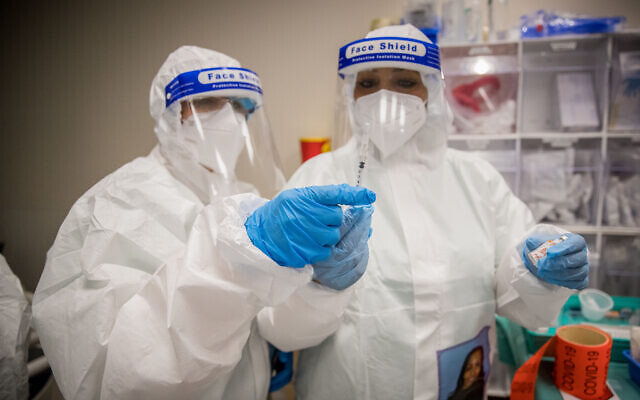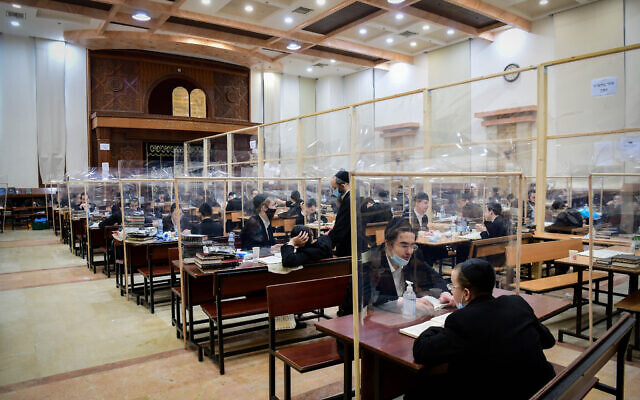The death toll from the novel coronavirus rose to 957 in Israel, the Health Ministry said Tuesday night, as infection numbers continued to hover near 2,000 cases a day.
According to figures provided by the ministry, 19 deaths were recorded in the 24 hours between Monday night and Tuesday night.
Monday saw the highest yet-single day death toll, with 20 fatalities from midnight to midnight, official numbers showed, pointing to a steady uptick in daily fatalities, which had averaged around 14 a day throughout August.
According to ministry data, 48 people have died of the virus since Sunday — and over 100 in the past week. It took 131 days from the first fatality on March 21 to reach 500 deaths on July 30, and just 34 days since then to nearly double the figure.
At the current pace, Israel will reach the grim milestone of 1,000 deaths over the weekend.
A total of 1,942 new infections were confirmed in the 24 hour between Monday night and Tuesday night, bringing the cumulative figure to 118,538.
Monday saw 2,183 infections recorded from midnight to midnight, the ministry said.

Staff wearing protective clothes as they work in the coronavirus ward at the Shamir Medical Center (Assaf Harofeh), near Tel Aviv, August 20, 2020. (Yonatan Sindel/Flash90)
The figures came as Israel pressed ahead with opening schools on Tuesday, despite what appears to be a slightr ise in daily infections, and amid fears that the start of the new school year could intensify the spread of the deadly disease.
Of the 21,367 active cases as of Tuesday night, 414 patients were in serious condition, including 116 people being treated with ventilators.
The ministry said 31,705 virus tests were conducted Monday as testing numbers appeared to return to normal following a short strike by public sector lab technicians earlier in the week.
Israeli officials have balked at reimposing wide-ranging virus restrictions, instead implementing a system meant to target only cities with high infection rates — or so-called “red cities” under coronavirus czar Ronni Gamzu’s “traffic light” plan.
Channel 12 news reported Tuesday that Gamzu is working on formulating new restrictions for those cities and local councils, which may soon include the ultra-Orthodox city of Bnei Brak.
On Monday, Bnei Brak became the second city, after Jerusalem, to record over 10,000 infections since the start of the pandemic. The Tel Aviv suburb was the first city put under a strict cordon in March and April as Israel fought the first wave of the pandemic.

Ultra-Orthodox Jewish men study in small groups at the Imrei Emes yeshiva of the Gur (Hasidic dynasty) in the city of Bnei Brak, June 16, 2020. (Yossi Zeliger/Flash90)
“A lockdown is on the table” in these areas, the TV network reported, though ultra-Orthodox politicians will likely strongly resist the plan.
Twenty-three cities and towns have been classified as “red” under the Health Ministry’s new designation system approved earlier this week. Most are Arab-majority locales, and a handful are ultra-Orthodox areas, with a number of exceptions.
According to the plan, gatherings are highly restricted and schools are closed in those areas. Less restrictive guidelines are in place for cities marked as “yellow” or “orange,” while the vast majority of cities, marked green, have only few restrictions on business operations or congregating in public spaces.

Israeli parents escort their children for the first day of school, during the coronavirus pandemic, in Tel Aviv on September 1, 2020. (JACK GUEZ / AFP)
Hours before the school year was set to begin on Tuesday morning, cabinet ministers voted to accept Gamzu’s recommendation to keep educational institutions shut in areas with high infection rates. The order keeping the schools closed lasts until Thursday, when the coronavirus cabinet is expected to meet again to reassess the situation.
Monday’s decision was a reversal for the ministers, who on Sunday had voted in favor of the “traffic light” proposal, but had excluded schools from the plan.
However, already on Tuesday there were reports that some schools in red zones had ignored the closure order.
Israel’s swift reopening of schools in May — after nearly eradicating the disease with strict lockdowns over the preceding months — was seen as a serious factor in the marked resurgence of the pandemic at that time.
 RSS Feed
RSS Feed















 September 2nd, 2020
September 2nd, 2020  Awake Goy
Awake Goy  Posted in
Posted in  Tags:
Tags: 













